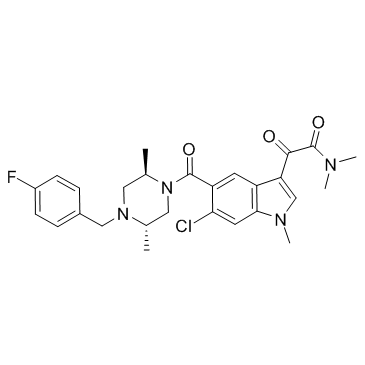| Description |
Talmapimod (SCIO-469) is a selective ATP-competitive p38 inhibitor with IC50 of 9 nM for p38α.
|
| Related Catalog |
|
| Target |
IC50: 9 nM (p38)[1].
|
| In Vitro |
Talmapimod (SCIO-469)decreased constitutive p38α MAPK phosphorylation of both 5T2MM and 5T33MM cells. Talmapimod (SCIO-469) also inhibits secretion and expression of the osteoclast-activating factors IL-11, receptor activator of NF-κB ligand, and macrophage inflammatory protein 1α, and prevents human osteoclast activationIn. It can also inhibit multiple myeloma growth and prevents bone disease in the 5T2MM and 5T33MM models.
|
| In Vivo |
Targeting p38α MAPK with Talmapimod (SCIO-469) decreases myeloma burden in addition to preventing the development of myeloma bone disease.
|
| Cell Assay |
5TMM cells (0.5 × 106/mL) were pretreated with different concentrations of Talmapimod (SCIO-469) in serum-free medium and then placed in the lower compartment of a Transwell system. Syngeneic bone marrow stromal cells were seeded into the Transwell itself. After 18 h, the 5TMM cells were collected from the lower compartment and stained for active caspase-3 with a FITC-labeled antibody according to manufacturer's instructions
|
| Animal Admin |
Animal injection[1] For studies of the effect of Talmapimod (SCIO-469) on myeloma development, three groups of male mice (n = 12) were injected i.v. with 0.5 × 106 5T33MM cells. Mice were left untreated (naive) or, if injected with tumor cells, treated from the time of tumor cells injection with either Talmapimod (SCIO-469) (150 or 450 mg/kg powder diet continuously available for the mice) or a vehicle (PBS) until the first mice showed signs of morbidity (at 3.7 weeks).
|
| References |
[1]. Hideshima T et al. p38 MAPK inhibition enhances PS-341 (bortezomib)-induced cytotoxicity against multiple myeloma cells. Oncogene. 2004 Nov 18, 23(54), 8766-76. [2]. Vanderkerken K et al. Inhibition of p38alpha mitogen-activated protein kinase prevents the development of osteolytic bone disease,reduces tumor burden, and increases survival in murine models of multiple myeloma. Vanderkerken K et al.
|
